The Start Screen, which was the noticeable feature introduced in Windows 8 last year, has now received and updated thanks to the recently released update i.e. Windows 8.1. You can swipe Start Screen, view it in Start or Apps mode. Technically, with Windows 8.1 you can also control the layout of Start Screen. Today in this article, we’ll show you the way to get a fixed layout using the new Start Screen Control feature in Windows 8.1
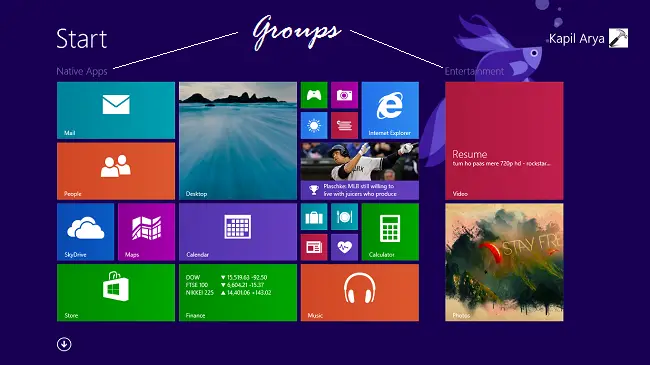
Start Screen Control
Shown above, is the screenshot of Start Screen in Windows 8.1, and it clearly shows that you can group the tiles and give the name to a group. As an example, we created a group “Native Apps” in the left and “Entertainment” as another group in the right. So let’s call it the fixed layout. It means, we want only this layout or in other words, no user should be able to make changes to it.
Specify a Fixed Start Screen Layout for Users in Windows 8.1
1. Firstly, open the Windows PowerShell as administrator and paste the following command to export the above shown Start Screen layout into an XML file:
Export-StartLayout -path <Output XML file path> -As XML
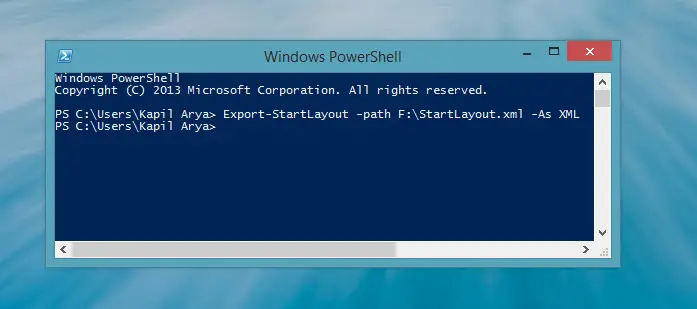
Here, in the above-mentioned command, edit the red part with your desired location to store the output XML file. We’ have to use this as the generated XML file in Group Policy Editor. If you don’t include the -As XML part, then the output will be a binary file, which will be meaningless for GPO. Here is XML file, as output:
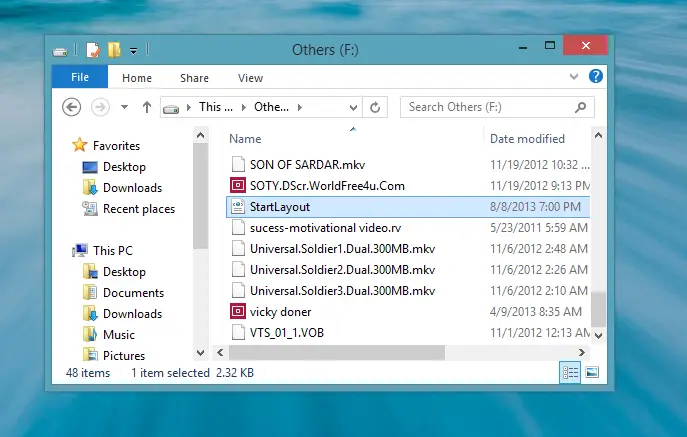
You can open the XML file in Internet Explorer to view the coding:
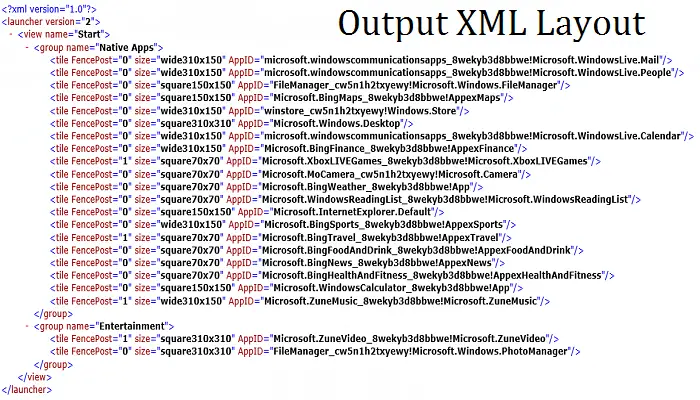
2. Now, open the Group Policy Editor by pressing Windows Key + R, and typing gpedit.msc followed by Enter key. In the Local Group Policy Editor window, navigate:
User Configuration -> Administrative Templates -> Start Menu and Taskbar
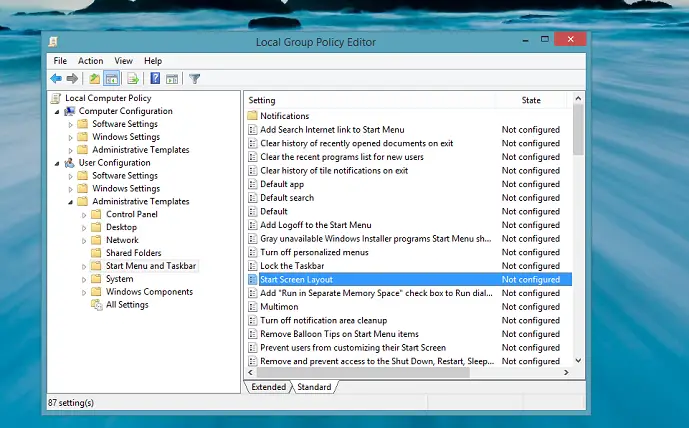
3. As shown in the above-shown window, look for the setting named Start Screen Layout and double click on it to open its configuration box:
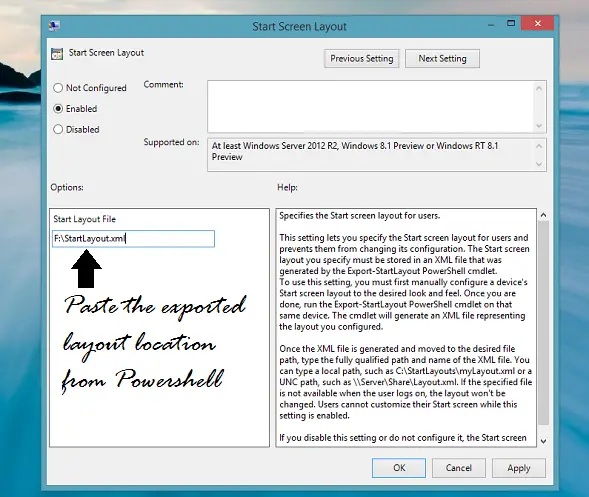
4. In the Start Screen Layout window, firstly select Enabled, then paste the location of the XML output file generated in step 1. Click Apply, followed by OK. Close Local Group Policy Editor and restart the Explorer to observe changes.
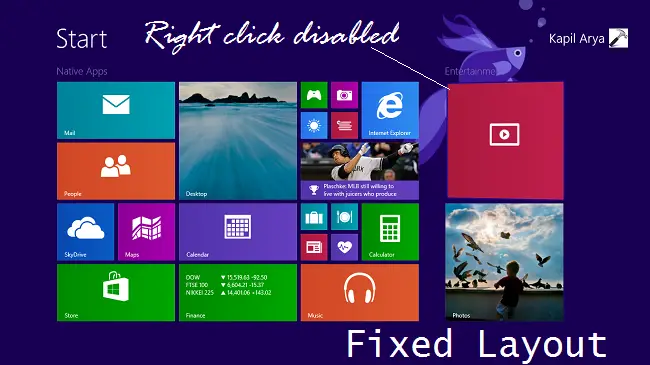
This policy setting specifies the Start screen layout for users. It lets you specify the Start screen layout for users and prevents them from changing its configuration. The Start screen layout you specify must be stored in an XML file that was generated by the Export-StartLayout PowerShell cmdlet. To use this setting, you must first manually configure a device’s Start screen layout to the desired look and feel. Once you are done, run the Export-StartLayout PowerShell cmdlet on that same device. The cmdlet will generate an XML file representing the layout you configured. If you disable this setting or do not configure it, the Start screen layout won’t be changedand users will be able to customize it.
Once this is done, you’ll find that customization to Start Screen has become locked now. And in this way the layout of Start Screen becomes fixed.
According to the MS documentation this feature only works for 8.1 Enterprise (at least for Group Policy deployment so I would expect for this method also). The method didn’t work for me on Win 8.1 Pro.
^^ Ditto, we tested it on Windows 8.1 Preview at the time of publishing this article and it worked fine then. By the way thanks for insights.
Why I have to buy “Enterprise” just to be able to customise the start screen is beyond me. Previous Windows “Pro” versions have allowed customisation via GP but suddenly this has become a “premium” feature? I won’t be rolling out this crazy start screen to my user base.
^^ This is actually MS’s strategy to keep Enterprise and Pro editions differentiated, and unfortunately we can’t change this.
Consider by doing this if your users install an app via the store they now have no way to uninstall that new app… oversight?
^^ You can always uninstall the app using Windows PowerShell.
Kids will be kids and I would rather not have students poking around with powershell… too much power there.
Instead look at delivering a default startscreen layout by putting down a appsfolderlayout.bin into the default user appdata location. As users loginto the devices for the first time they will pull this startscreen layout down and can then further alter the startscreen to suit themselves as well as uninstall apps as required while still allowing you to trim out the usual fat.
Hi KPRDave,
You suggested solution is what i am looking for too. Are you able to figure out how to do this?
Thanks.
Sure,
First take a look here it should get you going in the right direction:
http://technet.microsoft.com/en-us/library/jj134269.aspx
Second, and this may not apply to you but, I do my OS Deployments using SCCM 2012 R2. Near the end of my task sequence I have a software package containing the appsfolderlayout.bin file and run a small script:
FileCopy (“.appsFolderLayout.bin”, “C:UsersDefaultAppDataLocalMicrosoftWindows”, 1)
I should really revisit my process as it has been working nicely but I’m sure there is an updated method by now.
I hope this helps.
That helped a lot Dave! Thanks for the prompt reply and sorry for the late reply (was not able to find this page for a long time.)
I had this working in Windows 8.1 Pro, until I updated to all
the most recent patches. If this is indeed to differentiate between Pro and
Enterprise versions it doesn’t really gel with the recently announced unified
version of Windows. And to be honest, MS are really coming across as being
petty, it’s not that the Pro OS can’t do it is it?
Damn….i had this working for quite a while on 7 Windows 8.1 Pro tablets and suddenly it didn’t work anymore :-(
Tried everything and on the end I found out (also because of above reply) that it’s not working anymore on a Win 8.1 Pro installation and probably only on enterprise.
This is really ridiculous because in the GPO this is not noted, there it just says: Suppored on: At least Windows Server 2012 R2, Windows 8.1 or Windows RT 8.1.
This should be a very basic feature Microsoft! And i’m really pissed off regarding this.
Also when you compare both the Windows 8.1 Pro vs Enterprise features there is nowhere told that for example this GPO is not supported on the Pro version.
They only name the major feature difference…. :-(